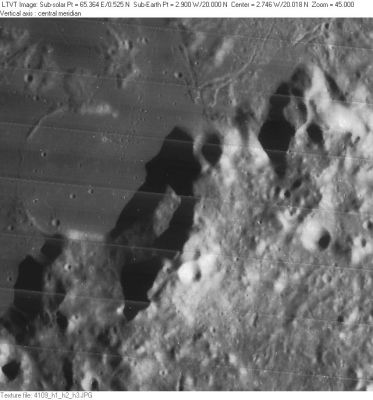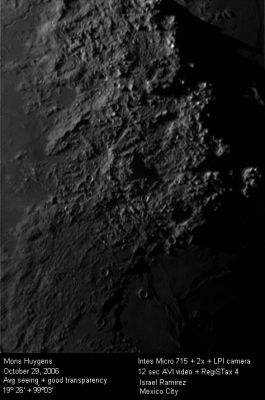Mons Huygens
Contents
[hide]Mons Huygens
|
Lat: 19.92°N, Long: 2.89°W, Diam: 41.97 km, Height: 5.4 km, Rükl: 22 |


Right: LO-IV-109 Mons Huygens is the north-south ridge-like mountain mass in the center of this north-up aerial view. The headland in the lower left is Mons Ampère. The tallest part of Mons Huygens is in the bright cratered area to the right of Mons Ampère. Still farther to the right is 6-km Huyens A, the only lettered crater named after the mountain. The other features, including the prominent triangular headland in the upper right and the 26-km diameter ghost crater on the floor of Mare Imbrium, are unnamed.
Left: Israel Ramirez This mirror-inverted Earth-based image shows sunrise over Montes Apenninus. In the upper left quadrant one can see a prominent diagonal ridge with a spine-like back. It has a medium sized crater surrounded by spoke-like features to its lower right. The crater is 28-km Marco Polo and the ridge was once known as Marco Polo Gamma. Tracing the ridge to the upper right (west), one can find the peaks of Mons Huygens near the terminator. Slightly below them, the two points of light mentioned by Danny Caes (see Additional Information), are elevated points on the spine of Mons Ampère catching the rays of morning light. The feature that looks like Mons Ampère below the two dots is actually some lower, unnamed peaks to its south.
Images
LPOD Photo Gallery Lunar Orbiter Images Apollo Images
- Apollo 17's orbital color Hasselblad photograph AS17-153-23585 shows Mons Huygens during post-sunrise illumination.
- The Metric/ Mapping Fairchild camera of Apollo 17 captured Mons Huygens in the centre of frame AS17-M-2431.
- Research orbital Apollo 17 photography: Danny Caes
Maps
(LAC zone 41D3) LAC map Geologic map LM map
Description
Elger
(IAU Directions) MOUNT HUYGENS.--A mountain mass projecting from the escarpment of the Apennines, in N. lat. 20 deg., W. long. 3 deg., one peak rising to 18,000 feet above the Mare Imbrium.
Wikipedia
Additional Information
- IAU page: Mons Huygens
- Depth data from Kurt Fisher database
- Viscardy, 1985: 5.4 km
- Cherrington, 1969: 2.28 km
- Although LM-41 places the label for Mons Huygens at the cratered northern tip of the mountain mass (an area once known as Huygens Beta), the highest point is indicated as being in the cratered area to the immediate east of Mons Ampère. The elevation there is shown as being about 5000 m above the floor of Mare Imbrium. Huygens Beta is shown as being about 640 m lower, while the unnamed promontory to the east of Huygens Beta is higher -- only 110 m lower than the highest point on Mons Huygens. - JimMosher
- A curious clair-obscur effect, noticed by Danny Caes, can be seen to the south of Mons Huygens when the morning-terminator runs at 9 degrees west (over Mons Pico). The sunlight catching the highest points on Mons Ampère creates the appearance of two bright "stars" or "dots" in a pitch black valley, as seen in Israel Ramirez' photo (above). Another interesting photograph of this effect was made by the dedicated lunar observer Stefan Lammel. It can also be seen in Plate C9 of the Consolidated Lunar Atlas. In Plate C10 the peaks are more strongly illuminated, and in Plate C13, Mons Ampère has come fully into sunlight. See also LPOD A New Look
Nomenclature
- Named for Christiaan Huygens (April 14, 1629 – July 8, 1695), a Dutch mathematician, astronomer and physicist. Historians commonly associate Huygens with the scientific revolution, and celebrate especially his argument that light consisted of waves. In the field of astronomy, with his brother Constantijn, Huygens made practical improvements in grinding of lenses, and in 1655, with one of these new lenses, discovered Saturn's moon Titan. Huygens was also the first to interpret the mysterious changing appearances of Saturn's rings as being the natural result of a highly flattened and tilted disk separate from the main body of the planet. At around the same time Huygens observed and sketched the Orion Nebula, publishing these results in his book Systema Saturnium (1659). Huygens was also highly noted for his contributions to timekeeping including his invention of the first practical pendulum clock.
- According to Whitaker (p. 218), this name was introduced by Schröter, who spelled it Huyghens, although it had been used previously by Van Langren. The name was apparently Latinized to Mons Huygens in the early 1960's (see the 1961 nomenclature directives in IAU Transactions XIB), although it was labeled simply Huygens (without "Mount" or "Mons") on both LAC-41 the Quad Maps of the System of Lunar Craters.
- Called Montes Huygens on Hans Schwarzenbach's moonmap of HALLWAG.- DannyCaes Oct 28, 2012
LPOD Articles
Bibliography
Named Features -- Prev: Huxley -- Next: Hyginus